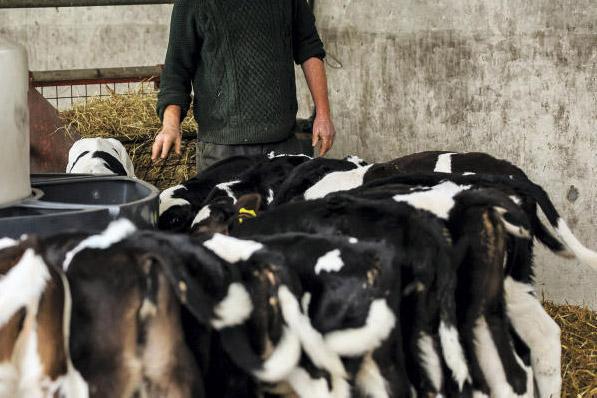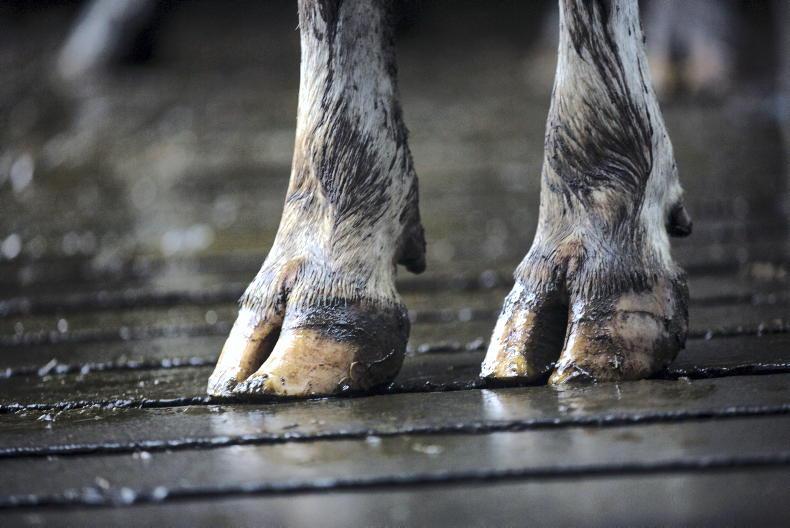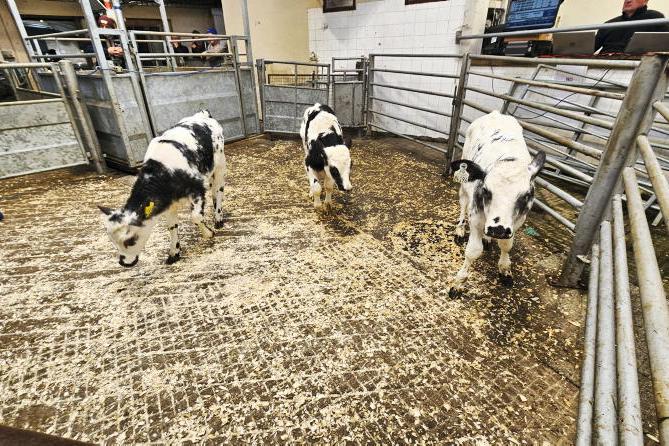In last week’s Irish Farmers Journal there was extensive coverage of what was said at various meetings held around the country concerning bull calves from the dairy herd.
The background is that dairy cow numbers have recovered to pre-quota levels, meaning there has been an increase in the supply of bull calves hitting the market.
The increase in supply is coinciding with lower demand for calves from beef farmers as beef prices are lower and some will say calf quality is poorer.
The profitability of all beef systems is seriously challenged. Increased supply, lower demand and bad weather affecting shipments of calves for export saw prices go up and down last spring. Market sentiment hasn’t improved since, if anything it has deteriorated.
Welfare concerns
Concerns have been raised about animal welfare standards on dairy farms. As stated last week, approximately 26,000 calves (or 1.7% of all calves born from the dairy herd) were slaughtered in meat plants last spring.
These calves are purchased from farms and in marts by agents and are transported by lorry and boat to France
The meat from these animals is processed and exported, mainly for human food consumption in north Africa.
Approximately 200,000 calves (or 14% of all calves born from the dairy herd) were exported last spring.
These calves are purchased from farms and in marts by agents and are transported by lorry and boat to France. From there, they continue their onward journey, usually to Holland or Spain.
Scrutiny
Both the early slaughter of calves in Ireland and the live export of calves are under scrutiny. Purely from an animal welfare point of view, the live export market is considered to be under more strain.
Early slaughter of calves by itself, while not presenting a wholly desirable image, isn’t technically a welfare issue once the calves are treated correctly prior to slaughter.
The last time cow numbers peaked was in 1984 when there were 1.56m dairy cows in the country
Therein lies the nub of the issue – the treatment of calves.
The last time cow numbers peaked was in 1984 when there were 1.56m dairy cows in the country.
There were more than 80,000 farms with dairy cows back then, compared with just over 17,000 farms now.
While the number of cows per farm was lower than it is now, technology and facilities weren’t as advanced.
However, lower labour efficiency was somewhat offset by the increased availability of labour in the 1980s.
Unemployment rate in that decade averaged almost 15%, while it is currently just over 5%.
Efficient
Even though farmers are clearly more efficient now, newborn calves still have to be fed, bedded and reared.
All of this takes time and resources and there’s no real substitute for it, particularly in the critical first few days of a calf’s life.
Risk to industry
While the overwhelming majority of farmers in Ireland treat their animals exceptionally well, there are cases where standards lapse. While bad for the animals involved, it also poses a risk to the whole industry. Even on very well-managed farms, video clips can be edited to make something look very bad. In reality, it’s easy to make something look bad if it suits your agenda and that is a challenge for everyone.
However, it’s important to remember that Irish dairy farmers have a good record on animal welfare.
People who say otherwise should look at the Department of Agriculture statistics. Data from 2018 shows that more dairy bull calves die, or are stillborn compared to heifer calves.
There is simply no evidence of systematic euthanasia or neglect leading to death of dairy bull calves in Ireland
Does this indicate poor welfare standards for bull calves? If it does, then the same is to be said for beef calves as a higher proportion of beef bull calves die, or are stillborn compared to heifer calves.
Mortality rates are higher among bull calves due to longer gestation lengths and harder calvings, regardless of breed or farm type.
There is simply no evidence of systematic euthanasia or neglect leading to death of dairy bull calves in Ireland.
In other sectors, undercover media investigations have exposed malpractice and incited public anger. Media exposure of abuse of the elderly in nursing homes and abuse of the young in crèches and childcare facilities is now a near annual occurrence in Ireland.
Further afield, but perhaps closer to home, media exposure of malpractice on dairy farms in New Zealand and the US has affected public opinion of dairy farming in those countries.
The next steps
Option 1: Do nothing
If nothing changes, it’s likely that the number of calves going for slaughter and export will increase.
Effectively, Ireland will be increasing its reliance on practices that are questionable from a public image and potentially animal welfare point of view.
Drawback: If farmers don’t take action themselves, new rules could be forced upon them.
Option 2: Reduce
low-value calves
Farmers can reduce the amount of low-value bull calves being produced from the dairy herd. This can be achieved through the establishment of a sexed semen sorting lab in Ireland. The target being that over time most dairy semen will be sold as sexed, as has happened in countries such as Denmark. The Dairy Beef Index could be used to pick all beef AI sires that are easy-calving and have higher beef merit.
Drawback: Research results on sexed semen have been mixed and choice of beef sires for dairy herds is poor.
Option 3: Spread out sales
Late February to early March is the peak calf sales period. Demand for calves cannot keep up with supply and price falls. Forced selling can also be attributed to insufficient calf-rearing facilities or a labour shortage on some farms. If facilities existed to keep calves on dairy farms for longer, then the spread of calves hitting the market could be spread out further, which could help the system to cope better.
Drawback: Extra calf sheds are needed along with people and equipment to manage and feed calves.
Option 4: Establish veal systems
In light of challenges to the export market, is it possible to establish veal farms in Ireland? Rather than export calves to the continent where they are reared for veal, some argue specialised farms should be set up in Ireland to rear and slaughter calves at eight to 10 months.
Drawback: Public perception of veal farming is poor. Seasonal calving makes establishing a viable Irish veal business very difficult. Also, finding a market for veal based on a short supply window will be difficult.
Option 5: tweak the EBI
Increasing the weighting of beef in the EBI would improve the beef characteristics of dairy cows. Some people propose banning the use of Jersey semen. Breeding a dual-purpose cow such as Fleckvieh, Montbeliarde or British Friesian would improve the beef merits of all dairy-bred calves.
Drawback: Increasing the weighting in one trait means reducing the weighting in other traits. As it stands, EBI is based on profitability so any changes to the EBI should be carefully considered. Some will argue that the calf issue is existential and is therefore related to future profits.
Option 6: Reduce dairy cow numbers
This would solve the problem of extra dairy calves.
Drawback: The re-introduction of quotas would limit future dairy growth in Ireland.
Option 7: Ban calf slaughter and live exports
This would mean an extra 226,000 calves would need to find a home in Ireland.
Drawback: If these calves are reared in Ireland and finished at between 21 and 26 months, it would increase the national kill by almost 9,000 animals per week over that six-month period.
Option 8: Only Sell older calves
Currently, calves can be sold from 10 days of age. If this sale age restriction was increased, to say four or six weeks, calves would be stronger and more resilient at time of sale/movement.
Drawback: Extra calf sheds are needed along with people and equipment to manage and feed calves. Also, the market could be flooded with calves in March/April. Under current animal health rules all calves have to be TB tested once they are over 42 days of age.
Option 9: Contract rear beef calves
In a contract-rearing scenario the calves would remain the property of the dairy farmer, but would be reared on a beef farm. The contract-rearing fee should cover all costs and leave a margin for the rearer.
Drawback: Contract rearing is hard on cashflow and in its most basic form all the risk and reward is put back on the dairy farmer.
Read more
Clampdown on dairy bull calves
‘Every cow should have a cubicle’ vet conference hears
In last week’s Irish Farmers Journal there was extensive coverage of what was said at various meetings held around the country concerning bull calves from the dairy herd.
The background is that dairy cow numbers have recovered to pre-quota levels, meaning there has been an increase in the supply of bull calves hitting the market.
The increase in supply is coinciding with lower demand for calves from beef farmers as beef prices are lower and some will say calf quality is poorer.
The profitability of all beef systems is seriously challenged. Increased supply, lower demand and bad weather affecting shipments of calves for export saw prices go up and down last spring. Market sentiment hasn’t improved since, if anything it has deteriorated.
Welfare concerns
Concerns have been raised about animal welfare standards on dairy farms. As stated last week, approximately 26,000 calves (or 1.7% of all calves born from the dairy herd) were slaughtered in meat plants last spring.
These calves are purchased from farms and in marts by agents and are transported by lorry and boat to France
The meat from these animals is processed and exported, mainly for human food consumption in north Africa.
Approximately 200,000 calves (or 14% of all calves born from the dairy herd) were exported last spring.
These calves are purchased from farms and in marts by agents and are transported by lorry and boat to France. From there, they continue their onward journey, usually to Holland or Spain.
Scrutiny
Both the early slaughter of calves in Ireland and the live export of calves are under scrutiny. Purely from an animal welfare point of view, the live export market is considered to be under more strain.
Early slaughter of calves by itself, while not presenting a wholly desirable image, isn’t technically a welfare issue once the calves are treated correctly prior to slaughter.
The last time cow numbers peaked was in 1984 when there were 1.56m dairy cows in the country
Therein lies the nub of the issue – the treatment of calves.
The last time cow numbers peaked was in 1984 when there were 1.56m dairy cows in the country.
There were more than 80,000 farms with dairy cows back then, compared with just over 17,000 farms now.
While the number of cows per farm was lower than it is now, technology and facilities weren’t as advanced.
However, lower labour efficiency was somewhat offset by the increased availability of labour in the 1980s.
Unemployment rate in that decade averaged almost 15%, while it is currently just over 5%.
Efficient
Even though farmers are clearly more efficient now, newborn calves still have to be fed, bedded and reared.
All of this takes time and resources and there’s no real substitute for it, particularly in the critical first few days of a calf’s life.
Risk to industry
While the overwhelming majority of farmers in Ireland treat their animals exceptionally well, there are cases where standards lapse. While bad for the animals involved, it also poses a risk to the whole industry. Even on very well-managed farms, video clips can be edited to make something look very bad. In reality, it’s easy to make something look bad if it suits your agenda and that is a challenge for everyone.
However, it’s important to remember that Irish dairy farmers have a good record on animal welfare.
People who say otherwise should look at the Department of Agriculture statistics. Data from 2018 shows that more dairy bull calves die, or are stillborn compared to heifer calves.
There is simply no evidence of systematic euthanasia or neglect leading to death of dairy bull calves in Ireland
Does this indicate poor welfare standards for bull calves? If it does, then the same is to be said for beef calves as a higher proportion of beef bull calves die, or are stillborn compared to heifer calves.
Mortality rates are higher among bull calves due to longer gestation lengths and harder calvings, regardless of breed or farm type.
There is simply no evidence of systematic euthanasia or neglect leading to death of dairy bull calves in Ireland.
In other sectors, undercover media investigations have exposed malpractice and incited public anger. Media exposure of abuse of the elderly in nursing homes and abuse of the young in crèches and childcare facilities is now a near annual occurrence in Ireland.
Further afield, but perhaps closer to home, media exposure of malpractice on dairy farms in New Zealand and the US has affected public opinion of dairy farming in those countries.
The next steps
Option 1: Do nothing
If nothing changes, it’s likely that the number of calves going for slaughter and export will increase.
Effectively, Ireland will be increasing its reliance on practices that are questionable from a public image and potentially animal welfare point of view.
Drawback: If farmers don’t take action themselves, new rules could be forced upon them.
Option 2: Reduce
low-value calves
Farmers can reduce the amount of low-value bull calves being produced from the dairy herd. This can be achieved through the establishment of a sexed semen sorting lab in Ireland. The target being that over time most dairy semen will be sold as sexed, as has happened in countries such as Denmark. The Dairy Beef Index could be used to pick all beef AI sires that are easy-calving and have higher beef merit.
Drawback: Research results on sexed semen have been mixed and choice of beef sires for dairy herds is poor.
Option 3: Spread out sales
Late February to early March is the peak calf sales period. Demand for calves cannot keep up with supply and price falls. Forced selling can also be attributed to insufficient calf-rearing facilities or a labour shortage on some farms. If facilities existed to keep calves on dairy farms for longer, then the spread of calves hitting the market could be spread out further, which could help the system to cope better.
Drawback: Extra calf sheds are needed along with people and equipment to manage and feed calves.
Option 4: Establish veal systems
In light of challenges to the export market, is it possible to establish veal farms in Ireland? Rather than export calves to the continent where they are reared for veal, some argue specialised farms should be set up in Ireland to rear and slaughter calves at eight to 10 months.
Drawback: Public perception of veal farming is poor. Seasonal calving makes establishing a viable Irish veal business very difficult. Also, finding a market for veal based on a short supply window will be difficult.
Option 5: tweak the EBI
Increasing the weighting of beef in the EBI would improve the beef characteristics of dairy cows. Some people propose banning the use of Jersey semen. Breeding a dual-purpose cow such as Fleckvieh, Montbeliarde or British Friesian would improve the beef merits of all dairy-bred calves.
Drawback: Increasing the weighting in one trait means reducing the weighting in other traits. As it stands, EBI is based on profitability so any changes to the EBI should be carefully considered. Some will argue that the calf issue is existential and is therefore related to future profits.
Option 6: Reduce dairy cow numbers
This would solve the problem of extra dairy calves.
Drawback: The re-introduction of quotas would limit future dairy growth in Ireland.
Option 7: Ban calf slaughter and live exports
This would mean an extra 226,000 calves would need to find a home in Ireland.
Drawback: If these calves are reared in Ireland and finished at between 21 and 26 months, it would increase the national kill by almost 9,000 animals per week over that six-month period.
Option 8: Only Sell older calves
Currently, calves can be sold from 10 days of age. If this sale age restriction was increased, to say four or six weeks, calves would be stronger and more resilient at time of sale/movement.
Drawback: Extra calf sheds are needed along with people and equipment to manage and feed calves. Also, the market could be flooded with calves in March/April. Under current animal health rules all calves have to be TB tested once they are over 42 days of age.
Option 9: Contract rear beef calves
In a contract-rearing scenario the calves would remain the property of the dairy farmer, but would be reared on a beef farm. The contract-rearing fee should cover all costs and leave a margin for the rearer.
Drawback: Contract rearing is hard on cashflow and in its most basic form all the risk and reward is put back on the dairy farmer.
Read more
Clampdown on dairy bull calves
‘Every cow should have a cubicle’ vet conference hears










SHARING OPTIONS